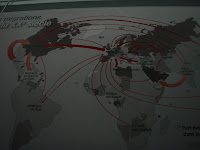October 13th, 2007
 On Wednesday 10th, October 2007 « La Cité Nationale de l'Histoire de l'Immigration » opened its doors to the public in the east of Paris. While French President Nicolas Sarkozy was present to inaugurate a new Museum of Architecture and Heritage (La Cité de l'Architecture et du Patrimoine) some weeks before, the French media did not fail to notice that neither the president, the first minister, nor the Minister of Immigration were there to inaugurate this museum.
On Wednesday 10th, October 2007 « La Cité Nationale de l'Histoire de l'Immigration » opened its doors to the public in the east of Paris. While French President Nicolas Sarkozy was present to inaugurate a new Museum of Architecture and Heritage (La Cité de l'Architecture et du Patrimoine) some weeks before, the French media did not fail to notice that neither the president, the first minister, nor the Minister of Immigration were there to inaugurate this museum.  As the New York Times reported, “This important museum tells the history of perhaps 25 percent of the French population, and it is stunning that it opened without the president of France,” said Patrick Weil, a historian of immigration. “It’s an insult, a denial of part of French history” (Sciolino 2007).
As the New York Times reported, “This important museum tells the history of perhaps 25 percent of the French population, and it is stunning that it opened without the president of France,” said Patrick Weil, a historian of immigration. “It’s an insult, a denial of part of French history” (Sciolino 2007).  Part of the reason for the absence of politicians from the governing party was the Mariani clause in the new immigration law being worked out in Congress which would allow for the use of DNA tests to prove paternity in cases of family reunion for people coming from countries that lack civil registers, and which has been the object of a lot of controversy and opposition (more on this on a following blog entry).
Part of the reason for the absence of politicians from the governing party was the Mariani clause in the new immigration law being worked out in Congress which would allow for the use of DNA tests to prove paternity in cases of family reunion for people coming from countries that lack civil registers, and which has been the object of a lot of controversy and opposition (more on this on a following blog entry). I went to the museum with some colleagues doing research on migration on October 13th, the first Saturday that the Museum was open. Because of its inauguration the entry was free. The attendance on the morning was modest but in the evening there was a long line to enter going around the corner of the building.
I went to the museum with some colleagues doing research on migration on October 13th, the first Saturday that the Museum was open. Because of its inauguration the entry was free. The attendance on the morning was modest but in the evening there was a long line to enter going around the corner of the building. The Museum used to house the Museum of the Colonies and Oversees Territories; a certain amount of exoticism remains in the art and architecture of the building, which gives a very clear message that the colonies were backward and savage and that France brought civilization to them.
The Museum used to house the Museum of the Colonies and Oversees Territories; a certain amount of exoticism remains in the art and architecture of the building, which gives a very clear message that the colonies were backward and savage and that France brought civilization to them.  The new museum makes the case that immigrants also have contributed much to France in different areas such as science as music, food, science, arts, sports, politics, and the military.
The new museum makes the case that immigrants also have contributed much to France in different areas such as science as music, food, science, arts, sports, politics, and the military. The Museum shows the different groups that have come to France from multiple countries and regions. The framing of migration presented in the museum is a positive one, and it includes a discourse about the advantages of diversity and it advances that France is more open now than it was before to foreigners moving to France; this outlook if partially the result of top-immigration scholars having participated in the design of the exhibition to different degrees and in different extents (not without political and ideological disagreements).
 The Museum itself is an important reminder about the immigrant nature of the French Nation. Nonetheless, the Museum still reminds inaccessible to non-Francophones since all of its written, audio and visual material exists exclusively in French.
The Museum itself is an important reminder about the immigrant nature of the French Nation. Nonetheless, the Museum still reminds inaccessible to non-Francophones since all of its written, audio and visual material exists exclusively in French.Le Monde. Le discret hommage de la France à ses immigrés. Le Monde. 10 Octobre 2007
Kimmelman, Michael.”Ready or Not, France Opens Museum on Immigration.” The New York Time. October 10, 2007. Corrected version October 17th, 2007
http://www.nytimes.com/2007/10/17/arts/design/17abroad.html?partner=rssnyt&emc=rss
Sciolino, Elaine. “Proposal in France to Test Some Immigrants’ DNA.” The New York Times. October 11, 2007
http://www.nytimes.com/2007/10/11/world/europe/11france.html?ref=design
http://www.nytimes.com/2007/10/17/arts/design/17abroad.html?partner=rssnyt&emc=rss
Sciolino, Elaine. “Proposal in France to Test Some Immigrants’ DNA.” The New York Times. October 11, 2007
http://www.nytimes.com/2007/10/11/world/europe/11france.html?ref=design
1 comment:
My first reaction to DNA testing was "that's absurd". But thinking about it a bit more ... it sort of makes sense. How are we to prove that X person is the father/mother of Y person?
The only con I see is costs, which is a problem. But I can't find a simple solution to this?
What happens now? If you can't prove you're related, can you not get papers? If so, then DNA testing is a must.
Two cents ..
Post a Comment